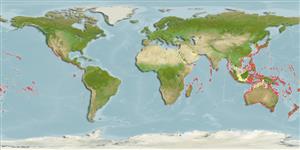Classificação / Names
Common names from other countries
Referência principal
Tamanho / Peso / Idade
Max length : 180 cm SL macho/indeterminado; (Ref. 9710); 124.0 cm SL (female); common length : 100.0 cm SL macho/indeterminado; (Ref. 9814); Peso máx. publicado: 14.0 kg (Ref. 9814); Idade máx. registada: 15 anos (Ref. 9814)
Length at first maturity
Lm 91.8, range 68 - 70 cm
Ambiente
; marinhas; Água doce; estuarina bentopelágico; anfídromos (Ref. 51243); intervalo de profundidade 1 - 30 m (Ref. 6898), usually ? - 15 m (Ref. 89972)
Clima / Intervalo
Tropical; 15°C - 43°C (Ref. 43081), preferred 26°C (Ref. 107945); 46°N - 52°S, 19°E - 77°W
Distribuição
Indo-Pacific: along continental shelves and around islands, where temperatures are greater than 20°C. Red Sea and South Africa to Hawaii and the Marquesas, north to Japan, south to Victoria, Australia. Eastern Pacific: San Pedro, California to the Galapagos.
Países | Áreas FAO | Ecossistemas | Ocorrências | Introduções
Descrição suscinta
Espinhos dorsais (total): 2; Raios dorsais (total): 13-17; Espinhos anais 2; Raios anais : 8 - 10; Vértebras: 46. This species is characterized by the following: body elongate and somewhat compressed; mouth small and toothless; branchiostegal rays 4; one dorsal fin; pectoral fins falcate; body olive green; flanks silvery; fins dark bordered (Ref. 55763). Superficially resembles bonefishes but by evolution more advanced by having 4 branchiostegal rays (Ref. 1602); jaws toothless (Ref. 12693); with 31 caudal fin rays (Ref. 50686).
Status na Lista Vermelha da IUCN (Ref. 115185)
Perigo para os humanos
Harmless
Uso pelos humanos
Pescarias: altamente comercial; Aquacultura: espécies comerciais; peixe esportivo: sim; isca: usually
Ferramentas
Relatórios especiais
Baixar XML
Fontes da internet
Estimates of some properties based on models
Phylogenetic diversity index
PD50 = 1.5000 many relatives (e.g. carps) 0.5 - 2.0 few relatives (e.g. lungfishes)
Nível Trófico
2.4 ±0.20 se; Based on food items.
Resiliência
Baixo, tempo mínimo de duplicação da população 4,5 - 14 anos (tm=4-8; tmax=15; Fec=200,000)
Vulnerabilidade
Very high vulnerability (76 of 100)
Categoria de preço
